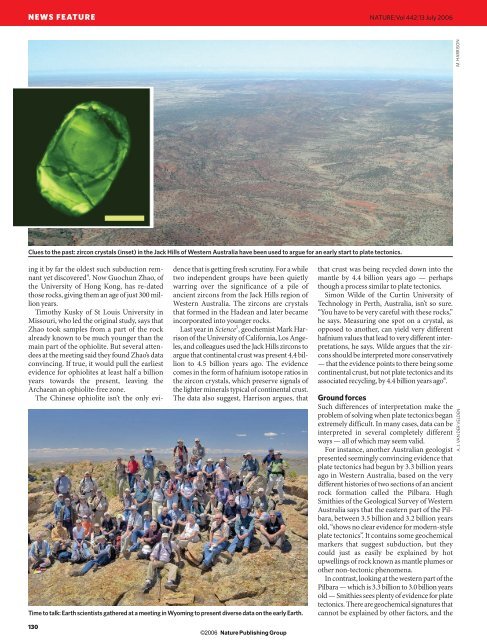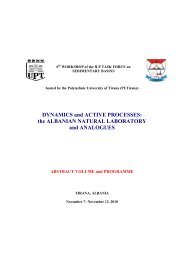JOHANNES GUTENBERG-UNIVERSITÄT MAINZ - International ...
JOHANNES GUTENBERG-UNIVERSITÄT MAINZ - International ...
JOHANNES GUTENBERG-UNIVERSITÄT MAINZ - International ...
You also want an ePaper? Increase the reach of your titles
YUMPU automatically turns print PDFs into web optimized ePapers that Google loves.
NEWS FEATURE NATURE|Vol 442|13 July 2006<br />
Clues to the past: zircon crystals (inset) in the Jack Hills of Western Australia have been used to argue for an early start to plate tectonics.<br />
ing it by far the oldest such subduction remnant<br />
yet discovered 4 . Now Guochun Zhao, of<br />
the University of Hong Kong, has re-dated<br />
those rocks, giving them an age of just 300 million<br />
years.<br />
Timothy Kusky of St Louis University in<br />
Missouri, who led the original study, says that<br />
Zhao took samples from a part of the rock<br />
already known to be much younger than the<br />
main part of the ophiolite. But several attendees<br />
at the meeting said they found Zhao’s data<br />
convincing. If true, it would pull the earliest<br />
evidence for ophiolites at least half a billion<br />
years towards the present, leaving the<br />
Archaean an ophiolite-free zone.<br />
The Chinese ophiolite isn’t the only evi-<br />
130<br />
dence that is getting fresh scrutiny. For a while<br />
two independent groups have been quietly<br />
warring over the significance of a pile of<br />
ancient zircons from the Jack Hills region of<br />
Western Australia. The zircons are crystals<br />
that formed in the Hadean and later became<br />
incorporated into younger rocks.<br />
Last year in Science 5 , geochemist Mark Harrison<br />
of the University of California, Los Angeles,<br />
and colleagues used the Jack Hills zircons to<br />
argue that continental crust was present 4.4 billion<br />
to 4.5 billion years ago. The evidence<br />
comes in the form of hafnium isotope ratios in<br />
the zircon crystals, which preserve signals of<br />
the lighter minerals typical of continental crust.<br />
The data also suggest, Harrison argues, that<br />
Time to talk: Earth scientists gathered at a meeting in Wyoming to present diverse data on the early Earth.<br />
©2006<br />
Nature Publishing Group<br />
that crust was being recycled down into the<br />
mantle by 4.4 billion years ago — perhaps<br />
though a process similar to plate tectonics.<br />
Simon Wilde of the Curtin University of<br />
Technology in Perth, Australia, isn’t so sure.<br />
“You have to be very careful with these rocks,”<br />
he says. Measuring one spot on a crystal, as<br />
opposed to another, can yield very different<br />
hafnium values that lead to very different interpretations,<br />
he says. Wilde argues that the zircons<br />
should be interpreted more conservatively<br />
— that the evidence points to there being some<br />
continental crust, but not plate tectonics and its<br />
associated recycling, by 4.4 billion years ago 6 .<br />
Ground forces<br />
Such differences of interpretation make the<br />
problem of solving when plate tectonics began<br />
extremely difficult. In many cases, data can be<br />
interpreted in several completely different<br />
ways — all of which may seem valid.<br />
For instance, another Australian geologist<br />
presented seemingly convincing evidence that<br />
plate tectonics had begun by 3.3 billion years<br />
ago in Western Australia, based on the very<br />
different histories of two sections of an ancient<br />
rock formation called the Pilbara. Hugh<br />
Smithies of the Geological Survey of Western<br />
Australia says that the eastern part of the Pilbara,<br />
between 3.5 billion and 3.2 billion years<br />
old, “shows no clear evidence for modern-style<br />
plate tectonics”. It contains some geochemical<br />
markers that suggest subduction, but they<br />
could just as easily be explained by hot<br />
upwellings of rock known as mantle plumes or<br />
other non-tectonic phenomena.<br />
In contrast, looking at the western part of the<br />
Pilbara — which is 3.3 billion to 3.0 billion years<br />
old — Smithies sees plenty of evidence for plate<br />
tectonics. There are geochemical signatures that<br />
cannot be explained by other factors, and the<br />
M. HARRISON<br />
A. J. VAN DER VELDEN




